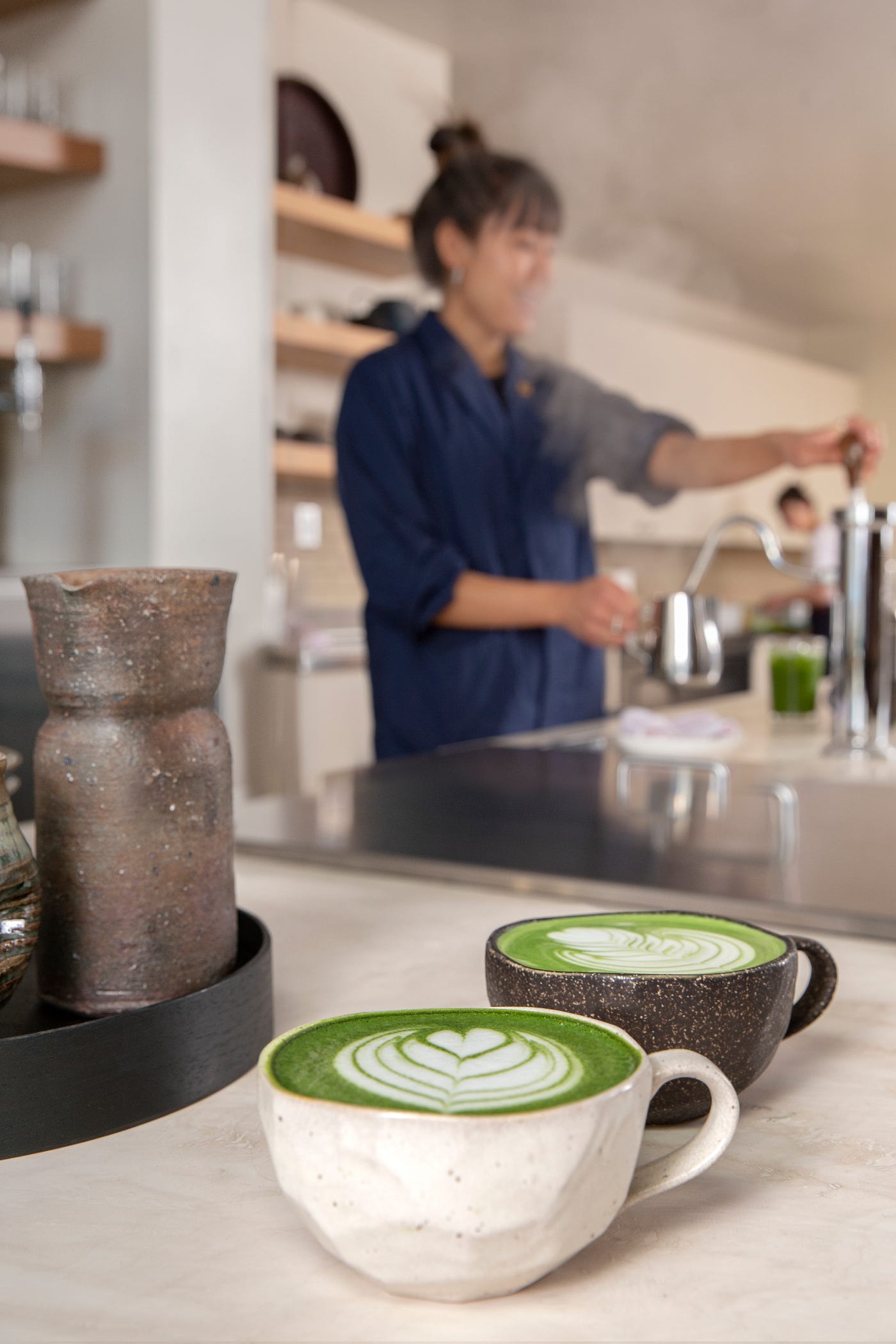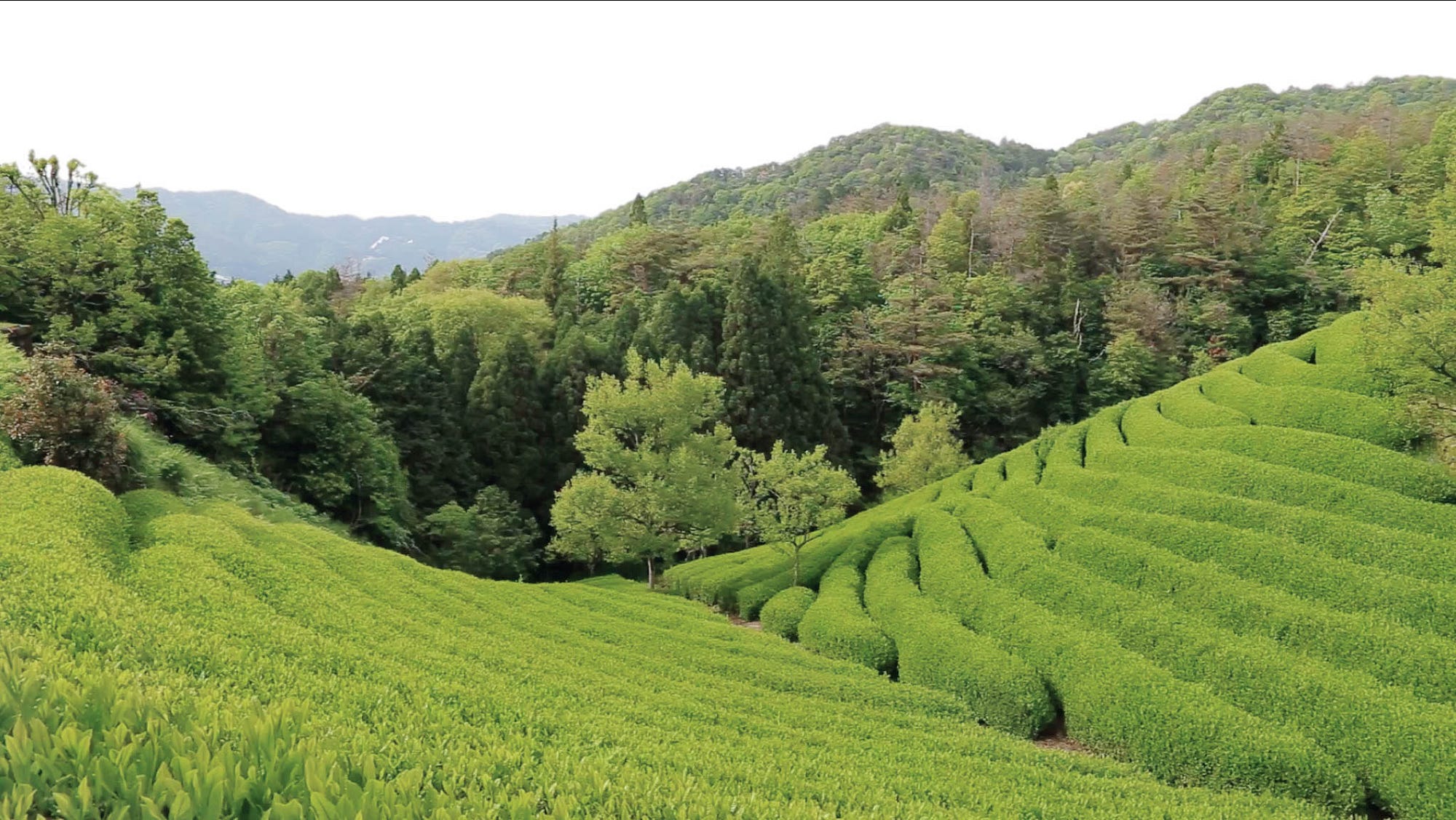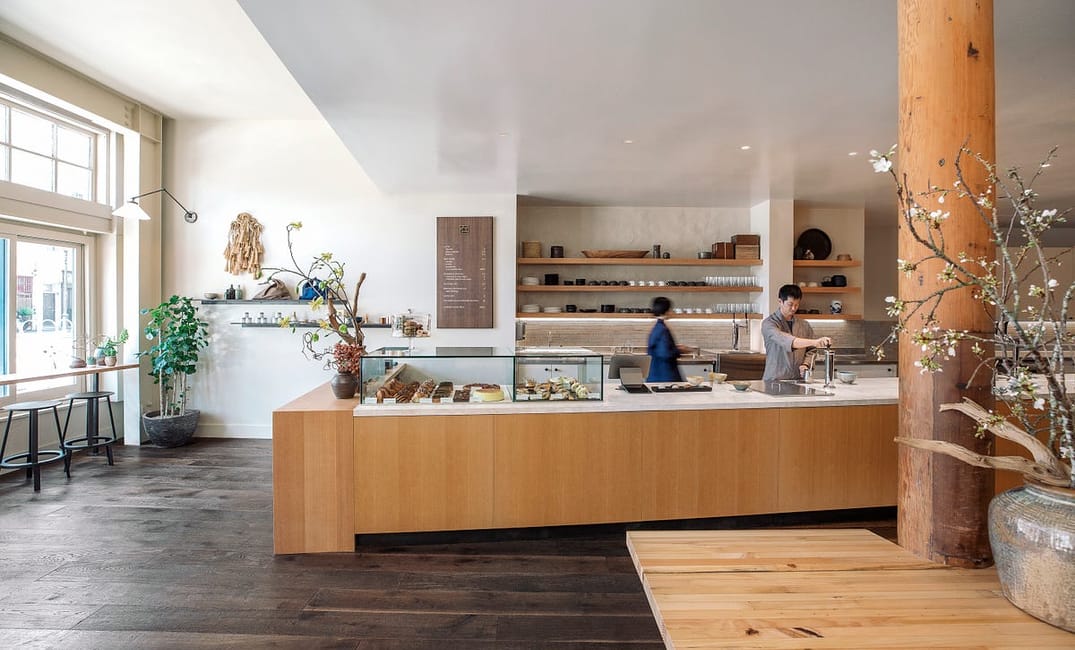
What struck me most when I arrived at Stonemill Matcha—a new and much-celebrated Japanese cafe on Valencia Street in San Francisco—on a recent Saturday afternoon was the stark contrast between the cafe’s Zen design and the chaos brewing inside it. The space resembled a clean and minimalist Japanese cha-no-ma, a gathering place for drinking tea, but was juxtaposed by swarms of twentysomethings Instagramming their matcha lattes and puff pastries.
“You should come visit us on a weekday,” Stonemill Matcha general manager Yoojin Chung said to me kindly as I stared, perhaps a little too aghast, at the busy cafe. “You can drink your matcha while reading your book in silence on those days—it’s actually pretty nice.”
As I struggled to hear Chung over the chatter, that did sound nice. I watched as she whisked my matcha in front of me at the slow bar, where guests can learn about the origins of matcha and enjoy it in a traditional serving style. Using a bamboo whisk, she stirred the almost boiling water and dark-green powder, turning it into a a light-green, seemingly creamy concoction. I had seen matcha made like this only once before, at a traditional teahouse in Kyoto, Japan, a few years back.
Take Starbucks, which uses a presweetened green-tea powder to make its matcha lattes to satisfy Americans’ sugar-loving palates. But in reality, the drink is nowhere close to the real deal.
I sipped my tea from a ceramic bowl, thinking about how different the ambiance was in that peaceful teahouse in Kyoto. The tea-ceremony master had encouraged me to savor it slowly and quietly. Meanwhile at Stonemill, I couldn’t help but want to quickly gulp the whole drink quickly, by no fault of Chung. The crowd was making me, the stereotypical introverted writer, somewhat anxious. But after drinking the tea, I started to feel a little calmer, so I tried to slow down and savor the little peace I could feel.
This calming effect is just one of the many reasons why matcha has made headlines in recent years, sending it to the top of the wellness community’s list of favorite products. The health benefits — which have also been said to include increased metabolism, a high level of antioxidants, lowered blood sugar and long-lasting energy without the crash—paired with the fact that its bright-green hue makes for a very Instagrammable shot (over 3.5 million Instagram posts are tagged with #matcha), have contributed to the matcha madness.
It’s left me to wonder, In the midst of this hype and Americanization of Japan’s most sacred tea, has the essence of matcha has been lost amid the noise?
The tea’s popularity has caused many players to enter the market simply to cash in on the trend, and you can’t blame them. But focusing on the novelty without actually preserving the essence of its true flavor or honoring its origins in Japan is a noticeable problem.
Take Starbucks, which uses a presweetened green-tea powder to make its matcha lattes to satisfy Americans’ sugar-loving palates. But in reality, the drink is nowhere close to the real deal. Actual matcha is made from green-tea leaves that have been steamed and grounded in a stonemill. The final product is supposed to have a flavor that is grassy and earthy — not sweet at all.
The Bay Area has been one of — if not the most — exciting cities on the matcha bandwagon. Matcha has practically become a staple flavor in ice cream shops, and dessert shops have been integrating matcha into their pastries.

It’s left me to wonder, In the midst of this hype and Americanization of Japan’s most sacred tea, has the essence of matcha has been lost amid the noise?
Fortunately, there are Bay Area tea purveyors who are trying to recapture the essence of matcha. And Stonemill Matcha is one of them. Despite what the crowds might indicate, founder Eijiro Tsukada tells me that he wanted to respect its traditions and make matcha—which he grew up drinking in his grandmother’s home back in Japan—a part of people’s daily rituals rather than just the object of a picture on social media.
The shop meets a happy middle ground, using high-quality ground matcha sourced directly from shade-grown farms in Kyoto but on a modern menu that includes drinks such as mizudashi (cold-brew matcha) and sparkling matcha with yuzu and cane sugar, on top of the expected matcha lattes and the traditional version.
I wondered, however, whether drinking these contemporary takes honor matcha in the same way a traditional, hand-whisked matcha would.
Tsukada thinks so. “I think as long as you’re using real, high-quality Japanese matcha, putting it in beverages and pastries is fine,” he said. “The problem is when restaurants claim to use matcha, but it turns out not to be real. You can often tell by the color — it should be beautifully bright green, but fake matcha has more of a yellow hue.”
Teance, a tea shop in Berkeley, is another key player that’s trying to bring traditional, high-quality matcha to the Bay Area. And it’s been around since way before the recent craze struck, having opened in 2002. Founder Winnie Yu has been fostering relationships with tea farms in China and Japan for decades.
Often, customers will be confused when their orders come out, Darius Moghaddam, director of operations at Teance, tells me. “We hand-whisk our matcha and serve it in a bowl, traditional style, so when the bowl of matcha comes out, some people don’t even know what to do with it.”
Meanwhile, Encha — a San Francisco-based online matcha supplier — is going beyond just providing the finest matcha to its customers — their matcha products are also organic. Founder Li Gong said meeting the farmer who would become his supplier was an eye-opening experience. The farmer’s father had started organic farming in 1987, before “organic” was a buzzword.
“You could see they truly cared about the land and people’s health,” he said.

Gong, who started the company in 2014, agrees that preserving the essence of matcha doesn’t require you to drink it in a traditional tea-ceremony setting but that it’s more important to understand the mindset behind it, and be ready to slow down for a moment.
“There are three notions that I think make up the essence of the tea ceremony — reflection, peacefulness, humbleness — which is very hard to cultivate in our very aggressive culture,” Gong said.
Education in these cases become especially important. “Here in the US, we are a coffee culture,” Moghaddam, from Teance, says. “We are up against that challenge to really educate people.”
That education component is the reason behind Stonemill Matcha’s slow bar. Similarly, Teance has tasting classes where attendees can make a bowl of on their own.
“It will take some time for matcha to replace any coffee-brewing habit at home — consumers will need to learn how to slow down their daily rituals to make room for matcha,” Gong said.
Hey! The Bold Italic recently launched a podcast, This Is Your Life in Silicon Valley. Check out the full season or listen to the episode below featuring Jessica Alter, founder of Tech for Campaigns. More coming soon, so stay tuned!







